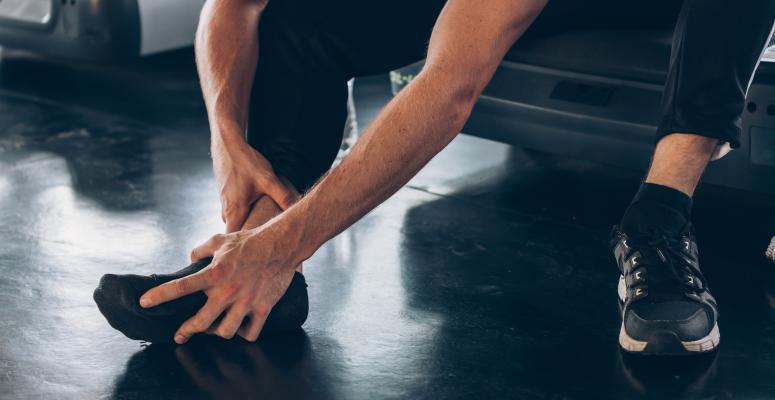
Foot and ankle pain is very common. In people aged 55 years and older, almost 2% reported having frequent joint pain in their foot or ankle. Foot conditions like ankle bursitis can cause you to feel pain that radiates from your ankle joint, especially around your heels. Unfortunately, bursitis can occur in any area of your body. Each year, at least 1 out of 10,000 people develop bursitis on their knees or elbows alone.
Bursitis, including ankle bursitis, is characterized by swelling, redness, and tenderness around your ankle and heel bone. If you have ankle bursitis, you may also experience:
- Pain when applying pressure to the back of your heel.
- Pain when standing on your tiptoes or leaning on your heels.
- Difficulty placing all your weight on your ankles.
If your bursitis symptoms are coupled with chills or other signs of a fever, you may have an infection. In that case, you should seek medical attention immediately. In most cases, however, your bursitis can be treated via at-home or noninvasive exercises and techniques such as physical therapy.
By paying attention to your ankle bursitis symptoms and pain levels, you can begin a treatment plan that reduces your inflammation and restores your mobility.
What is ankle bursitis?
A bursa is a fluid-filled sac that cushions and lubricates your bones when you move. Bursae fluid protects your bones from rubbing against other tissue like your ligaments and tendons.
You have bursae all over your body, but the one at the back of your foot near your ankle is called the retrocalcaneal bursa. This bursa is located between your heel bone and your Achilles tendon. It is responsible for lubricating your ankle joint, encouraging your mobility, and making ankle movement fluid and smooth.
Bursitis refers to a condition in which one or more of your bursae become inflamed. This can happen suddenly after an impact injury, or over time as a result of a repetitive strain injury. You can also develop ankle bursitis if you:
- Overuse your ankle from running or jumping.
- Wear poor-fitting shoes over a long period of time.
- Exercise without proper warmup techniques.
- Have ankle arthritis.
- Still feel effects from a previous injury.
If you’re concerned that you have ankle bursitis, your doctor can diagnose you via a physical examination and an imaging test such as an X-ray or MRI scan. These images can help your doctor rule out other ankle conditions that may be causing your pain, such as tendinitis in your Achilles tendon. You can also see a physical therapist who can help you determine the source of your ankle inflammation.
How can you treat ankle bursitis?
Ankle bursitis can be incredibly painful and frustrating to deal with. Thankfully, most cases of bursitis heal on their own. If your bursitis has been especially painful, you can try the following noninvasive techniques to help:
- Ice and heat — Applying heat to your ankle can increase blood blow to your injury and ease tension in the surrounding tissue. Applying ice, on the other hand, can reduce blood flow and reduce swelling around your inflamed bursa. You can alternate using both methods to achieve optimum pain relief as you manage your ankle bursitis symptoms.
- Rest and elevation — Elevation can be an important natural remedy while you heal from ankle bursitis. When you elevate your swollen ankle above your heart, you encourage circulation and prevent fluid from collecting in your ankle. If you elevate as well as rest from weight-bearing activities over a period of time, you can help prevent further injury and boost your recovery time.
- Physical therapy exercises — Physical therapy exercises can help you take an active step in your recovery from ankle bursitis. Your physical therapist can combine strengthening exercises and manual therapy techniques to break up your ankle inflammation, increase your mobility, and decrease your pain. Physical therapists can also guide you in exercises that you can replicate at home on a consistent schedule. Doing these exercises on a regular basis can help promote healing in your ankle.
As you recover from ankle bursitis and start to walk with less pain, you should make sure you wear roomy, comfortable shoes that don’t pinch the back of your foot. Comfortable shoes can be the first line of defense against developing bursitis in the future. In addition, you can use shoe inserts that cushion and stabilize your foot within your shoes so that you can further avoid a recurrence of ankle bursitis.
Alliance PTP is ready to help you find top-notch PT for ankle bursitis
Are you tired of ankle pain caused by bursitis or need help determining if your ankle pain is linked to bursitis? At Alliance Physical Therapy Partners, we’re proudly bringing together physical therapy practices across the country to help people get the high-quality PT they need.
Want to see a physical therapist in person? We can put you in touch with an Alliance PTP partner that’s close to you and that can help you address your ankle pain and inflammation.
Not keen on in-person PT sessions or not close to an Alliance PTP partner? No worries. We also offer effective and affordable virtual physical therapy through our Agile Virtual Physical Therapy platform.
Come find help for your injury or chronic condition today!
Get Help at a Location Near You
